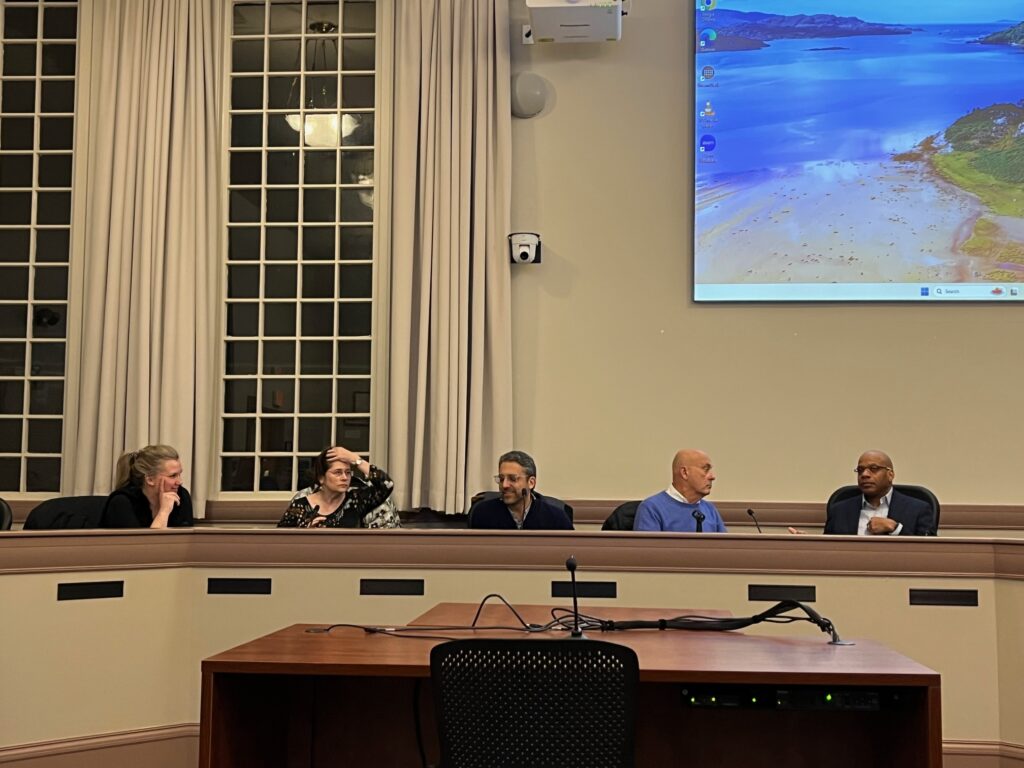Panel Explores Challenges of Building Affordable Housing in Amherst

East Gables Studio Apartments, Amherst, MA. Photo: Western Builders
Report on the Town of Amherst, League of Women Voters and Amherst Municipal Housing Trust’s Affordable Housing Forum, January 23, 2025
The League of Women Voters of Amherst, the Town of Amherst, and the Amherst Municipal Affordable Housing Trust (AMAHT) sponsored an information forum and question and answer period on affordable housing at Town Hall on January 23, 2025. The forum, entitled “Building Homes and Breaking Barriers,” brought together representatives of local housing advocates who pointed out the urgent need for affordable housing and the barriers to building new units at the state and local level. The question-and- answer period was moderated by Representative Mindy Domb. The forum was livestreamed and recorded. About 25 people attended the session at Town Hall. The number of people participating on Zoom was not announced.
Allegra Clark of the AMAHT stated that the number of people seeking shelter this winter has increased by 18% over last year. According to the director of Craig’s Doors, Tim McCarthy, there are currently 28 people at the congregate shelter at the Immanuel Lutheran Church and 58 housed at the EconoLodge in Hadley. When East Gables supportive studios opened last year, there were 501 applications for the 28 units, and 121 of those applicants lived, worked, or had school children in Amherst.
Clark cited the challenges for housing in Amherst as the lack of affordable rentals, the need for more affordable homes for first -time homebuyers, and the impact of off-campus student housing on residential neighborhoods. She noted that the Housing Production Plan Needs Assessment indicated that 82% of Amherst renters experienced cost burdens (spending more than 30% of their income on housing), as did 31% of homeowners. The average rent for a four-bedroom apartment in Amherst is 11% higher than the national average, and the median sales price of a home in Amherst in 2024 was $600,000, which is more than twice what a family of four earning the average median income can afford.

Keith Fairey of Way Finders noted the 2021 study by the UMass Donahue Institute that showed a need for an additional 19,000 housing units in the Pioneer Valley by 2025, especially for those who need deeply affordable housing costing less than $500 per month. It is projected that only 1,500 units in 19 Western Massachusetts towns will be created by 2028 at a cost of $500 million, not even meeting 10 percent of the need at a great cost.
Fairey cited vacancy rates in the area of one percent for homeowners and five percent for rental units. He also said that residents in Western Massachusetts on average pay 52% of their income in housing and transportation, as opposed to 38% of Suffolk County residents. The state recently affirmed its support for housing creation by passing a $5.16 billion housing bond bill. A commission is currently writing policies for how that money can be spent.
Laura Baker of Valley Community Development Corporation cited the challenges to building an affordable housing project. She said the planning, permitting, and construction usually take five to seven years and that costs rise greatly with longer delays. A major issue is finding a suitable site, since a minimum of 20 units is needed to make a project viable. Community opposition also increases costs. She noted the resident resistance to East Gables which necessitated several community meetings and the mobilization of a broad group of advocates. Current projects at Ball Lane and Belchertown Road/East Street School have not encountered the same local opposition. Approval from the Zoning Board of Appeals took nine meetings and over six months. Baker estimated that delays resulted in an additional cost of $2 to $3 million. Panel participants estimated that it now costs between $500,000 and $600,000 per unit created.
Peter Sarafino of Home City Development described the difficulty of financing affordable housing projects. Unlike private developers who can obtain a bank loan, developers of affordable housing must apply to numerous federal, state, and local agencies. Using the soon to open 34-unit Amethyst Brook project in Pelham as an example, he listed the many sources of financing, including $500,000 from the Pelham Community Preservation Act. The project received financing from over ten sources.
Housing Advocacy in Amherst
Former Chair of AMAHT John Hornik cited a study by Karen Levine Einstein of Boston University who looked at advocacy for affordable housing in 97 communities. She found that most participants in public hearings were older, white homeowners, and only 14% spoke in favor of affordable housing projects. Hornik said that it looked like Amherst was following suit with the vocal opposition by neighbors to East Gables, but some residents organized in support of the project and supporters outnumbered those in opposition in oral and written comments by a three to one margin. He said that the project “didn’t just happen,” organization was crucial.
Hornik noted housing challenges in Amherst. He cited the high rent for student apartments, student rentals in neighborhoods, and limited opportunities for homeowners. He also said there are few affordable places for older adults who want to downsize. He has advocated for senior housing at the town-owned property at Hickory Ridge, noting that when residents were asked their priorities for the parcel, affordable housing topped the list.
However, the town administration has decided to put a fire/EMS station at the site, despite the opposition of firefighters to this particular location and the need for housing. “This town is great at soliciting public input and then ignoring it,” Hornik asserted. When Town Councilor Pat DeAngelis (District 2) noted that former Fire/EMS Chief Tim Nelson approved of Hickory Ridge as the site for a new fire station, Hornik replied, “The fire chief works for the Town Manager, and is not independent. The new fire station should be located at the current DPW site, and a new site be found for the DPW.” He encouraged those present to weigh in regarding the creation of affordable housing at Hickory Ridge.
As for the UMass initiative to create more housing on campus through public private partnerships, Hornik was skeptical. He said a previous initiative six or seven years ago went nowhere, and the new housing created on campus replaced that which was torn down and did not expand the number of units on campus.
Should Amherst Consider 40R Zoning?
Baker noted that 40R zoning, which Amherst considered but rejected for downtown (see here, here, here, here, here, here and here.) is a useful way to promote affordable housing and reduce the red-tape involved. Forty-R zones allow increased density and provide for a more streamlined approval process. Forty-R projects can be approved by the Planning Board through a site plan review, rather than going through the ZBA for a special permit as is required for 40-B projects like East Gables and Belchertown Road and East Street School. Valley CDC has used the 40R process for several projects in Northampton. The state also gives the town incentive payments for schools when 40R is used.
Panelists were asked about their favorite affordable housing projects in the area. Baker cited Butternut Farms which fits well into the Orchard Valley neighborhood. Fairey liked a repurposed school in Springfield.
.

Thank you for this article Maura!
I wanted to clarify the 18%- nationally, during the homeless point in time survey, with counts the number of both sheltered and y sheltered persons without permanent homes, the number of people increased by 18%. In Massachusetts, in 2024, our unhorsed population increased by 54%. I don’t have the regional breakdown, though the numbers of people working with Craig’s Doors shows there is a need locally.
I also wanted to share something Laura Baker said which really resonated- “ we’re building for people living in their cars and they’re (referred to conversations at planning board meetings) having conversations about how much closet space is enough.” I think this so poignantly illustrated the need to have people with lived experience participate in decision making.